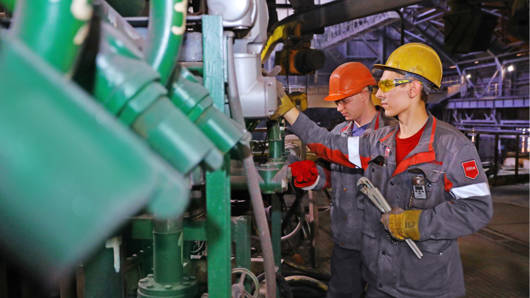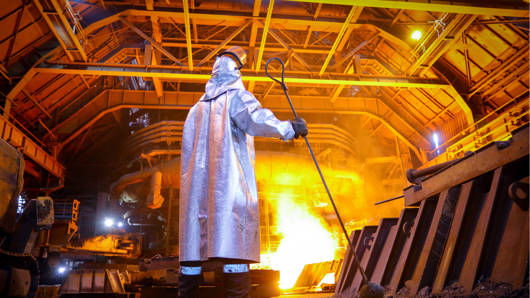In an interview with Pryamiy Channel, Oleksandr Myronenko, chief operating officer of Metinvest Group, spoke about the development, production and testing of steel screens to protect military equipment from FPV (first-person view) drone attacks. He also discussed important feedback from the military about this project, which is being implemented as part of Rinat Akhmetov’s Steel Front initiative, and shared plans to build the largest underground hospital on the front line.
- When Ukraine’s defence forces received American Abrams tanks and Bradley IFVs (infantry fighting vehicles), it turned out that they are vulnerable to kamikaze drones. Steel Front launched the production of protective screens for our and American tanks. How did you come to produce these screens? How do they work?
- Like other projects, this started as a collaborative effort with the military. When they encounter a certain situation on the battlefield, they turn to us to help find engineering solutions.
Currently, the main source of damage to our equipment is enemy FPV drones, so there was a need for additional defence.
We started the project about a year and a half ago by producing protective screens for Soviet T-64 and T-72 tanks. The screens fully cover the turret and engine compartment, as well as gaps where a drone can fly in and immobilise a tank or jam its turret. This impacts a vehicle’s combat effectiveness and its ability to evacuate from the battlefield. The screens primarily protect the lives of soldiers while also helping to increase the tank’s survivability.
We have produced several hundred of these protective devices for Soviet tanks. When the Ukrainian defence forces started receiving Western equipment, it turned out that even Abrams tanks or Bradley IFVs were insufficiently adapted to the latest changes in modern warfare and needed additional protection. That is why we have developed screens for the Abrams, almost all of which have already been installed. And now we are developing protective screens for the Bradleys. I think that the first samples will go for testing in about a week.
This is how works: we develop and deliver the first sample to the military. They test it at a training area. If we get feedback that everything is fine, we move on to mass production. Otherwise, we refine it considering the comments from the soldiers and then provide new samples for testing. If there are no issues, we start mass production.
- How do the Americans themselves react to the installation of such screens on their equipment?
- There has never been such widespread application of drones in combat as in Ukraine today. This includes Iraq, Afghanistan and other combat zones where Abrams tanks have been used. For this reason, the Americans did not have experience protecting tanks from such drone attacks. While their equipment is more modern than Soviet-era vehicles, it also has certain shortcomings and is quite vulnerable to drones. So, it also requires additional protection to ensure battlefield survivability.
- What are the protective screens made of?
- They are made from steel that is produced at our enterprises in Ukraine. The designs are welded at off-site facilities working to improve the country’s defence capability. The assembled kits and installation instructions are sent to the rear training areas where the tanks are located. There, military personnel install them on the equipment themselves.
We try to make the structure easy to install. Once delivered to the training area, they take about 12 hours to install on a tank. This happens quite fast when there is a ready-made kit and instructions on how to install it.
- How long does it take to produce such screens?
- It takes up to 10 days to produce one kit for the Abrams, for example. For Soviet tanks, it takes two to three days. The differences are in size, weight and design, because the Abrams is bigger and is built differently. This made it a challenge for us to adapt to the new vehicle. Before, we had reached relatively large-scale production of the protective screens, although only for Soviet tanks. We did not expect to also need to develop additional protective screens for the Abrams. When we found out that they also get damaged during combat operations, we immediately started developing designs and test samples.
- Who came up with the idea of installing such screens on tanks?
- If I am not mistaken, the installation of screens began back in 2014, when IFVs and APCs (armoured personnel carriers) were protected using screens to defend against ATGMs (anti-tank guided missiles). When the drone issue arose, we simply improved the previous solution. This is a new development that has been created with time and changes in combat operations given the mass use of drones.
- How do you assess the effectiveness of screens that protect against drones? To what extent do they protect the tank and the people inside it?
- I have seen quite a lot of our screens that have deterred enemy drone strikes. They take the impact on themselves. In my opinion, this increases the battlefield survivability of the tank against drone strikes by 30-40%. By protecting those areas where a drone hit could disable the tank, the screen helps to keep the tank from becoming immobilised. A stationary tank is an easy target for enemy artillery and ATGMs. It can be taken out relatively easily when it is not moving. The screen also protects the crew compartment, increasing the chances of crew survival even if the tank suffers some damage.
- If the screen takes the impact on itself, does it need replacement or repair in case of damage?
- That depends on what hit it. It will not protect from direct hits by artillery or tank shells. If it is an ATGM or drone, the screen will be damaged and will probably require complete replacement of the part that was hit.
- You mentioned that the development of screens for Bradley IFVs is underway. How will the testing be conducted?
- There are many details: the troop compartment also must be protected while still allowing it to open correctly. The design is currently under development. In about a week, the first samples will be sent to the training area for testing. Once we receive feedback from the military, we will be able to scale up production and equip the Bradleys that are currently operating in Ukraine.
This is a joint effort with the soldiers. Our engineers are present for testing and can see how the design works in the field, onboard feedback, understand whether it interferes with the movement of the vehicle or turret, and so on. They can immediately adjust the blueprints, improve the design on site and then send an improved version for retesting.
- Can you share some real stories where feedback from the military helped?
- For example, we have received several photos of damaged tanks along with words of gratitude from the soldiers because the crew survived. The tank was damaged and immobilised on the battlefield. It was then evacuated for repairs. While such a hit could have harmed the soldiers, thanks to our screen, they stayed alive and were very grateful. The most important feedback we receive is the gratitude of the soldiers who we have helped to stay alive and continue to fight the enemy. Although I would not say that there are hundreds of such stories, there have been dozens over the past three years of war.
- Have you made any adjustments to the designs during those three years?
- Even for Soviet vehicles, the designs are constantly changing. Our enemy is also constantly changing the munitions they use to strike tanks and adapting their FPV drone tactics. That is why we change the design depending on the potential damage that the new types of munitions the enemy uses can inflict on tanks.
- Are Western partners planning to somehow use these developments for themselves in cooperation with you in the future?
- I think they will use them. They do not have as much experience as our military and engineers in countering such an insidious and powerful enemy. This enemy has a very wide range of means to defeat both tanks and other equipment.
The wars fought by our partners pitted modern Western weapons against old Soviet designs. Today, we are fighting with modern Western weapons, while our enemy is also fighting with modern weapons. It is constantly improving and developing new ammunition. So, I am sure that our Western partners will apply the experience that our fighters are now gaining to develop their defence equipment. I have had several conversations with Western journalists. I see great interest from them and the military.
They ask about efficiency. They ask how and why we designed the screens. They are very interested in practical experience and feedback from soldiers. Why do these specific designs need to be installed? What are the peculiarities of using certain drones? Why should the vehicle be protected in this way and not in another way? The experience gained in the field is invaluable; you cannot get it anywhere else.
- The enemy also changes drones. Does this mean that the armour and protection for armour need to be modified, as well?
- Of course. That is why we are constantly adapting to the challenges the enemy poses and improving our protection so that our military’s equipment can work and effectively beat the enemies in the east of the country.
- How do you conduct testing and how do you approve the finished samples before they are delivered to the front?
- We conduct testing together with the military. We take one kit, go to a training area and install it on a combat vehicle. Then this vehicle starts moving, firing training shots and articulating the turret while moving and stationary. We look at how the protective screen performs: whether it interferes with movement or creates any additional obstacles when the crew needs to evacuate the vehicle. All these things must be considered: when, God forbid, there is real damage to the vehicle, we must be ready. For example, nothing should prevent the soldiers from exiting the vehicle to survive.
We do not start scaling up production until we have perfected the design. Once we reach an agreement with the military, we can begin serial production of dozens or hundreds of units.
- What other projects are you working on? What are you working on apart from protection for Bradley IFVs?
- Our main project is an underground field hospital for the front line. We should complete the design in the first half of July. The hospital will be provided with surgical, intensive care and wounded stabilisation wards. It will be based on our steel shelters.
This will be the largest field hospital of its kind in Ukraine. It will make it possible to triage and stabilise wounded soldiers for further transport to inpatient medical facilities. The most important aspect of battlefield medicine is to stabilise wounded defenders as quickly as possible so that they can then receive more comprehensive medical care.










